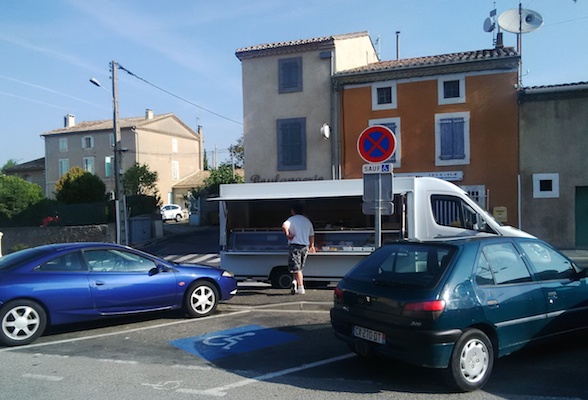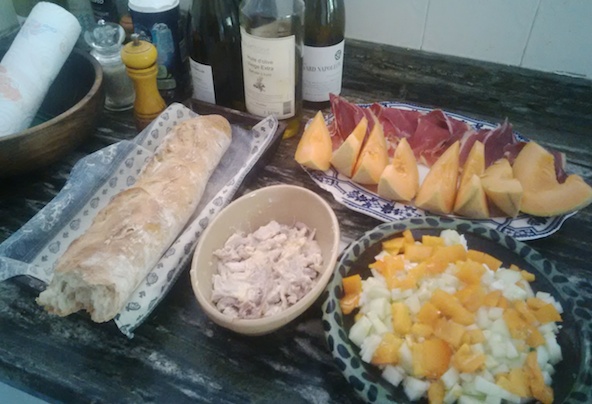Later, on 8 Aug I have just substituted this great collection of images assembled by our daughter Rose, who managed to get out of bed early enough to accompany her father to Carcassonne market this morning. Isn't she clever? (And when she was doing all this, I told her off for not helping get breakfast ready...) – JR
I am not reviewing restaurants this weekend for two reasons, one far more obvious than the other.
The first is that we are on holiday. The second is that while this break provides for many the pretext to visit several restaurants and enjoy the fact that their staff do all the cooking and the washing up, where we are on holiday in the Languedoc there are really not that many interesting places to go out to eat at.
The best are at least an hour’s drive away towards, and obviously, over the Pyrenees and into Spain, as I have described in previous years, but that just seems too far away. Maybe it is a sign of age but when the weather is good we would rather stay put. And when it is dull and overcast, as it is as I write this, and unusually sticky in a region of France the locals refer to as le pays du vent, the windy countryside, then the roads will be extremely crowded.
This is the kind of day when every parking space around Carcassonne will be taken as families pour in to walk its ramparts, buy plastic swords and have their first, and perhaps only, confrontation with cassoulet, the traditional hefty dish of the region that comprises pork, duck, beans and sausage, with carrots and onions providing light relief. This dish is still hugely popular with the older people who live here, even in the middle of August, but more of that surprising fact in a while.
And yet, as these two photographs illustrate, buying basic food ingredients can provide an insight into how a region lives, and has lived, for many a year. And how little certain practices change and how close we are to witnessing the extinction of others.

The picture above, taken after our daily foray to the village baker (the boulangerie sign can just be made out behind the travelling meat van), is an amalgam of what everyone believes exists in every French village but is today not often the case at all.
When we first landed here in 1989 there were at least two bakeries in the village. For several years there was none and my morning then began with a 5-kilometre drive each way to the next village for bread. Eight years ago a couple reopened the old bakery, with the financial backing of the Mairie opposite, and happily they have gone from strength to strength. Their Grand Siècle loaf, which comes out of their ovens at 9 am, is a foot long, the thickness of a man’s wrist, and has the most irresistibly crunchy crust. It is so moreish that it presents anyone who eats it with the same dilemma: how to take just enough butter or jam to finish off your piece of bread without, of necessity or greed, having to go back for another piece of bread.
These bakers now seem happily settled, their business good enough reward for their long hours. Schools and old people’s homes provide the bedrock of the business year-round with those travelling on the boats along the canal supplying the profit from May to September. This role allows them to be social barometers too. This year, they report, the number of holidaymakers is slightly down overall with fewer British tourists but more Australians.
Their bakery is also the hub of the village and it is no surprise therefore to find the travelling butcher in conversation with the baker. These travelling shops are very much de la région, journeying from one small village to another during the course of a morning as so many individual artisans used to do. Their arrival is heralded by the continuous honking of their horn. One side of the vehicle comes down and within a few minutes a small queue of elderly women, each clutching an ancient shopping bag, has formed and they politely talk to one another.
No more than 15 minutes, and a few sales, later the driver closes up and is on his way to the next small village. There are three such vans that have been passing through our village for the past 26 years, one selling meat, another selling fish with the magnificent name of Poissonerie Conquoise, and the third selling dairy and cheese. They provide a real service to their customers but, I would guess, probably do not generate a very positive financial return on investment or time.

This second image hints at why any local restaurant faces such strong competition – the ingredients round here are so good and so inexpensive. The cucumbers, which really taste as cucumbers should, are €1.50 for three. The melons, succulent and headily ripe, were bought directly from the farm that also sells tomatoes and is located right by a bend in the Canal du Midi so that it catches every one passing by on a boat or a bicycle. They are €5 for three. As an extra, free, service, the lady selling them will put biro marks on each melon to tell you in which order to eat them (0 for today, 1 for tomorrow, 2 for the day after).
The bright yellow tomatoes were on sale in Carcassonne market and were part of a very colourful selection on a stall manned by a woman at least 10 years my senior. A woman not to be tampered with would be a fair description with justifiable pride in all the produce on her stall: aubergines, leeks, French beans and many other shades of heritage tomato that were available at just €2 a kilo. She was also conspicuous by her hair: at 8.30am there was not a single strand out of place.
The ham, and most of our meat, comes from an equally industrious but perhaps even more earnest butcher with the unforgettable name of Monsieur Modeste Mas. Modeste is also a traiteur, preparing a lot of food for those who live close by and all the village fêtes. As I was going out of his busy butcher’s shop one day I bumped into a man carrying two enormous paella dishes back to Modeste’s kitchen. But this butcher is also testimony to how little has changed down here, for the time being at least.
I always try to call in by 8 am and on a day when the midday temperature was due to hit 34 ºC I was asked whether I liked tripe. I replied enthusiastically, adding the rider that I liked it when the weather was cooler than today. Modeste laughed. He had portions of tripe and cassoulet ready for today, for customers who had ordered them and would enjoy eating them despite the heat. I explained that I was quite happy enough that day with my ham. But certain eating habits in the Languedoc seemingly never die.

